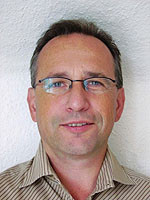Filová E, Rampichová M, Litvinec A, Držík M, Míčková A, Buzgo M, Košťáková E, Martinová L, Usvald D, Prosecká E, Uhlík J, Motlík J, Vajner L, Amler E. Int J Pharm. 2013 Apr 15;447(1–2):139–49. doi: 10.1016/j.ijpharm.2013.02.056. Epub 2013 Mar 7. IF: 3.458

Department of Biophysics
Abstract
The aim of the study was to evaluate the effect of a cell-free hyaluronate/type I collagen/fibrin composite scaffold containing polyvinyl alcohol (PVA) nanofibers enriched with liposomes, basic fibroblast growth factor (bFGF) and insulin on the regeneration of osteochondral defects. A novel drug delivery system was developed on the basis of the intake effect of liposomes encapsulated in PVA nanofibers. Time-controlled release of insulin and bFGF improved MSC viability in vitro. Nanofibers functionalized with liposomes also improved the mechanical characteristics of the composite gel scaffold. In addition, time-controlled release of insulin and bFGF stimulated MSC recruitment from bone marrow in vivo. Cell-free composite scaffolds containing PVA nanofibers enriched with liposomes, bFGF, and insulin were implanted into seven osteochondral defects of miniature pigs. Control defects were left untreated. After 12 weeks, the composite scaffold had enhanced osteochondral regeneration towards hyaline cartilage and/or fibrocartilage compared with untreated defects that were filled predominantly with fibrous tissue. The cell-free composite scaffold containing PVA nanofibers, liposomes and growth factors enhanced migration of the cells into the defect, and their differentiation into chondrocytes; the scaffold was able to enhance the regeneration of osteochondral defects in minipigs.
For another article about nanofibers please click here.